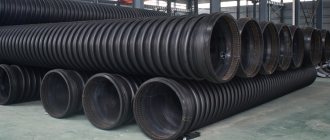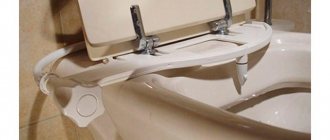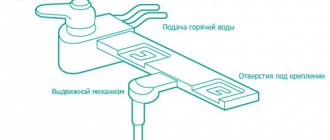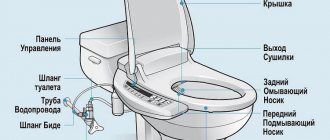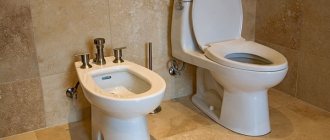The bidet installation is a modern special structural element based on a self-supporting frame.
This type of system, along with its components, is intended for the installation of hanging-type plumbing fixtures.
Let us consider in detail the rules for installing this structure.
Advantages of the installation system
The frame system, equipped with pipe bends and control elements, allows not only to save maximum space in the bathroom, but also has the following advantages:
- Makes the location of the plumbing fixture very comfortable. For installation of the installation, you need to allocate a small space near the wall.
- Allows you to optimize space. An ergonomic and compact bidet, mounted on the wall, occupies a minimum usable area, therefore it is optimal for installation in small bathrooms.
- Facilitates the maintenance of plumbing fixtures. The hanging device is accessible for washing from any side, and the floor area under the device always remains free, which makes cleaning the bathroom easier.
- Characterized by safety of use. The metal frame, which is the main structural element of any installation, is capable of withstanding significant loads, in the range of 300-400 kg.
- It is reliable and durable. Proper installation of the bidet bowl, installation frame and decorative screen guarantees high strength without compromising functionality during operation.
Bidet installation
It should be noted that all popular domestic and foreign manufacturers necessarily complete their products with detailed instructions and schematic drawings, so independent installation of the installation and plumbing fixture does not cause difficulties even in the absence of experience.
The main disadvantages of the installation include the need to dismantle the protective screen to carry out repairs, as well as the fairly high cost of high-quality suspended plumbing kits.
Myths about hanging plumbing
There are popular misconceptions regarding the installation and use of wall-hung toilets:
- Installation of the structure will require a lot of space due to the need to install a false wall. This is wrong. Since the installations are mounted directly on the wall, the space required to install a wall-hung toilet is the same as to install a traditional compact cistern.
- To repair problems with water supply or drainage, you need to disassemble the wall. We hasten to please you - you won’t have to touch the outer cladding. You can get the parts of the tank through the flush button. It serves as an inspection window.
- Hanging sanitary ware cannot support heavy weight and is not suitable for large people. This is also a myth, since according to the standard, installations must withstand weights of up to 400 kg, and some models are designed for loads of up to 600 kg.
Bidet installation system design
There are currently two types of installations available for fixing a plumbing fixture such as a bidet. The design differences between frame and block systems must be taken into account when choosing.
Installation diagram
Block design
Block-type installations are based on a body structure with areas for fixing the main reinforcement. Such models are intended for installation exclusively on solid brick or block walls, due to the lack of floor support.
Block installation
Installation of the block structure is carried out using standard anchor bolts, which take on a significant part of the total load.
Frame design
A more common option, characterized by structural complexity and based on a metal frame with places for reinforcement fixation. The frame structure is attached at two points on the wall and at a couple of points on the floor.
The advantages of frame installation include the ability to adjust the installation depth, as well as accessibility for installation without expanding the size of the niche.
Installations of this type are presented:
- frame structures fixed to monolithic walls;
- frame structures fixed to lightweight partitions;
- universal frame structures.
Frame design of the installation
The first option has a standard device, and the second type of design is based on a supporting frame that takes on a significant part of the total load.
Modern universal frame installations are characterized by a unified design that allows any of the traditional installation options.
Typology
The principle of hidden installation underlying the device eventually resulted in the production of two options:
- blocky,
- framed
In the first case, the structure is recessed into the wall without support. Therefore, this method is also called unsupported. From a financial point of view, this installation technology compares favorably with the support one. But due to the complexity of the process, it is used to equip public bathrooms.
In individual construction, the second type is popular - frame. The welded frame is made of metal profiles with anti-corrosion coating. Retractable frame supports are designed for mounting plumbing fixtures.
Installation of the module is carried out through “dry installation”, without the use of cement mixtures. The installation is covered with sheets of plasterboard or special panels.
The system is fastened using the supports of the supporting frame. If the product has the ability to adjust the crossbars, an acceptable height and depth must be established before work begins. After this, the bowl is attached to the frame and, if necessary, a floor screed is made.
Installation of the installation frame
There are several basic rules that must be followed regardless of the design features of the installation frame:
- the process of installing a frame structure must begin with high-quality leveling of the floor surface;
- the block structure is fixed on the wall, and the frame installation is attached not only to the wall, but also to the floor;
- it is necessary to adjust the location of the fasteners in height using retractable legs, which allow you to raise the frame by 40 cm;
- the depth of the location of the frame structure should be adjusted using special extensions that allow you to change the initial position by a maximum of 18 cm;
- block structures are “hung” on the wall with a preliminary selection of the mounting location and alignment of the level of the plumbing fixture;
- the frame or block structure must be fixed using anchor bolts, which are screwed into pre-drilled holes;
- The dimensions of the fastening elements must be selected in accordance with the weight of the plumbing fixture, as well as taking into account the maximum permissible load during operation.
Installation drawing
Thus, the process of preparing for installation of the structure includes leveling the surface, marking the points for screwing in the anchors and drilling holes for fasteners in accordance with the markings.
The main stages of installation are fitting the frame and temporary fixation with anchors, adjusting the position of the structure using extensions and legs, as well as finishing anchor bolting.
Since a bidet is not the most common household item, not everyone knows how to install it correctly. You can install the bidet yourself. Read the instructions and do everything in order.
Bidet lid - see this review for functionality and types.
What types of shower heads there are for a hygienic shower and which one is better to choose, we will tell you in this article.
Main types of breakdowns
The installation itself is difficult to break or spoil. Its frame is made of durable metal, and the top is coated with an anti-corrosion compound. Some designs can withstand up to 500 kg. This parameter may differ between different manufacturers, but usually not much. The main thing is not to buy installations that are too cheap. They can bend or crack even under an average weight person.
The main problem is related to the formation of leaks. If the tightness of the connection between the bidet and the water pipes is broken, they usually tighten the nuts of the supply pipes more strongly or add sealing material - wrap fum tape or flax. If there is leakage at the junction with the sewer pipe, change the rubber gasket. Over time, it hardens and ceases to perform a sealing function.
Blockages in the drain pipe are removed with a plunger or cable. Sometimes household chemicals are used, but at the end everything must be washed thoroughly.
Problems may lie in the integrity of the bidet itself. If cracks appear on it, it will not be possible to repair them; you will have to replace the bowl. Cracks that have formed around the fasteners or on the base of the floor-standing bidet can be repaired. Holes are drilled into the edges of these cracks to prevent further cracking. The surface is cleaned with sandpaper and degreased with a solvent. Resin or glue is poured into the voids, and after drying, these places are processed with a grinding machine.
Pipe connection
Connecting a plumbing fixture to the water supply system is based on the use of a conventional wall-mounted or built-in mixer. In the first case, the connection is made in the same way as installing a traditional faucet on a sink, and the second option requires mandatory gating.
As a rule, all mixers are sold with instructions or a so-called connection diagram, according to which the following is carried out:
- fixing the mixer;
- connecting flexible hoses to the mixer;
- connecting a flexible line to a tee of a water pipeline.
Low installation
As practice shows, it is advisable to install separate shut-off valves, which will allow you to autonomously shut off the water supply to the plumbing fixture. In this case, it is much easier to carry out such basic activities as routine preventive inspection and bidet repair.
It is equally important to correctly connect the installed plumbing fixture to the sewer system using a special siphon, a corrugated hose, and a rubber cuff, which ensures the sealing of the connection.
Bidet installation
Self-installation of a hanging bidet using the installation design is carried out in several main stages:
- install metal pins into special holes that will secure the bowl of the wall-mounted bidet;
- install a standard protective gasket on the installation structure, which, if necessary, can be replaced with a layer of silicone sealant;
- fix the bidet structure on the installed studs with a bolted connection.
Hanging bidet after installation
Wall-hung bidet and toilet
Geberit installation - bidet installation
The installed bidet is connected to the water supply system and sewerage, after which the functionality of the plumbing fixture is checked, and finishing with cladding panels is carried out.
It is important to remember that standard studs inserted into the mounting holes on the frame structure should be located at a distance of 18-23 cm from each other.
Technologies
According to Russian marketers, 40% of the housing stock is old-style buildings. The layout of water pipes, bends, risers differs unfavorably from sewerage systems in new buildings.
Old utility lines do not have clearances for mounting mounting studs. This causes a lot of problems when installing the module.
- Geberit engineers were the first to solve the problem. The developers have created a unique Plattenbau mount, consisting of two interchangeable elements: 50 cm long plumbing pins and an adjustable strip. The operating principle allows you to install frames in houses of any age.
- Another innovation developed for the same purpose is side mounts for corner models, making it possible to simultaneously install two adjacent installations. The pioneer of the innovative solution is the Alcaplast concern, which also offered the consumer supports with an increased width (up to 1200 mm).
- Slims are considered the pinnacle of plumbing art - super-thin systems with a panel made of glass or plastic. An interesting model is the Grohe Rapid SL made in Germany. The product can be attached to the wall and be a free-standing design element in the bathroom interior. The new product with a hanging bidet belongs to the premium price segment.
Price
Currently, a wide range of installations for installing a bidet is produced. The self-supporting frame allows you to easily and quickly connect plumbing fixtures of any brand and model.
The following brands, costing 5 thousand rubles and more, have proven themselves best:
- Geberit Combifix;
- Geberit Monelith premium;
- Viega Eco Plus;
- Ideal Standard;
- Sersanit Link;
- Grohe Raid.
The best replacement for a bidet would be an electronic bidet lid, as it has advanced functionality and can be controlled from a remote control.
Whirlpool bathtubs are made from different materials - acrylic, cast iron, steel. Cast iron bathtubs are the most durable, but they also have disadvantages. You can read about the pros and cons of cast iron whirlpool baths in this publication.
It is important to remember that the installation cannot be too cheap, since in this case one can doubt the quality of the design, on which the reliability and safety of the bidet’s operation, as well as the durability of the plumbing fixture, directly depend.
